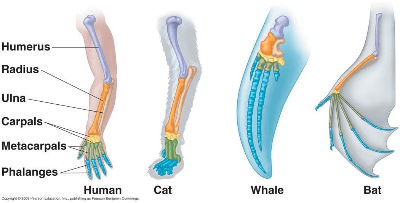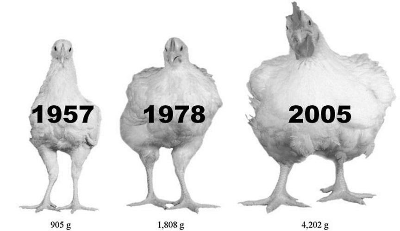In this IBDP biology post, we'll be going through the initial introduction and definition of phrases within the evolution topic such as homologous structures and fossil record, let's do this!
Evolution: Occurs when heritable characteristics of a species change over time
Four pieces of evidence for evolution:
- Fossil record
- Homologous structures
- Selective breeding
- Melanism
Fossil Record

Fossil: Preserved remains or traces of any organism from the remote past
- Direct (body fossils) such as
bones, teeth, shells and leaves
- Indirect (fossil traces) such as footprints, tooth mark traks
Fossil record: Sum of all the discovered and undiscovered fossils and their relative placements in rock
- The layer of rock can be dated and used to deduce the age of the fossil
Gaps in the fossil record are due to:
- Special circumstances are required for fossilization to occur
- Only hard parts of an organism are preserved
- Fossils can be damaged so that only fragments remain
The fossil record clearly shows changes in the characteristics of organisms. Fossils show a chronological sequence in which characteristics appear and develop in complexity
Transitional fossils: Shows the links between groups or species by exhibiting traits common to both both the ancesteral group/species and its derived decendant/species
Archaeopteryx is an example of a transitional fossil that provides evidence for the evolution of birds from dinosouars
Bird features: Feathers
Dinosaur features: Jaws with sharp teeth, three fingers with claws, long bony tail
Homologous structures & Adaptive Radiation
Homologous structures: Structures that have evolved from the same part of a common ancestor
Example of homologous structure: Pendactyl limb in vertebrates. All these vertebrates share an ancestor that had pendactyl limbs
Adaptive Radiation: Different groups have evolved from a common ancestor, but use different types of locomotion, the limbs developed in a variety of different ways to suit the type of locomotion
- Bat wing for
flying
- Horse hoof for
galloping
- Monkey hand for
grasping
All the organisms share the same bones. The bones may vary in size and shape but all vertebrates have five fingered "hands" at the end of each limb
Selective Breeding
Selective breeding: Selecting individuals with disirable traits and breeding from them
- The differences in heritable characteristics of domesticated breeds gives evidence that species can evolve from artificial selection
Melanism
Melanistic: Dark varities of typically light coloured insects
Example: Peppered Moth
- Melanistic variety was very rare and then industries developed allowing the melanistic variety to become more common
- A higher proportion of the melanic variety survived to breed and pass on the dark wing colour causing populations to evolve from peppered to melanic
Gradual Divergence
- If populations (example: fruit flies) become separated (two islands) then it is very likely that the population will experience different ecological conditions
- As a result of
- natural selection
- over many generations the shape of the flies, food prefrence and mating rituals will
- diverge
- If the island fruit flies migrate back to the mainland they will not easily mate with the population that stayed on the mainland because:
- Their mating rituals are different
- Due to genetic differences the resulting offspring are infertile
- Populations will gradually diverge over time and it is natural to see
continuous variation across a geographical range
Continuous variation: A series of intermediate types connects the extremes
- The bigger the geographical separation and the longer the populations have been seperated the greater the divergence
That's all! Well done!

Drafted by Venetia (Biology)



